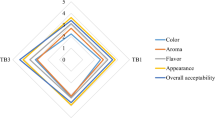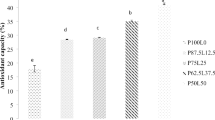Abstract
There is a growing interest in herbal teas due to their health promoting properties. In this study, chemical composition, antioxidant activity and consumer acceptance of Buddleja saligna herbal teas were determined. Protein (14 g/ 100 g) and carbohydrate (85 g/ 100 g) were the major nutrients in fresh leaves and processed green, oolong and black teas. Ash, crude fiber and lipids were very low in all samples. Fe contents of oolong and black (28 mg/100 g) were almost twice that of fresh leaves. Green tea infusions showed the highest total phenolic contents (5 GAE g/ml), which were twice those of oolong and black teas. By DDPH (2,2-diphenyl-1-picrylhydrazyl) assay, black tea infusion exhibited a slightly high radical scavenging activity (81.5 % ± 3.8) compared to green tea (78.6 ± 3.7) and oolong (78.4 ± 2.8). Oolong tea and black teas were the most liked for their taste and mouth feel compared to green tea.


Similar content being viewed by others
References
Adedapo AA, Jimoh FO, Koduru S, Masika PJ, Afolayan AJ (2009) Assessment of the medicinal potentials of the methanol extracts of the leaves and stems of Buddleja saligna. BMC Comp Alt Med 9:21–29
Adewusi EA, Moodley N, Steenkamp V (2011) Antioxidant and acetylcholinesterase inhibitory activity of selected southern African medicinal plants. South Afr J Bot 77:638–644
Adnan M, Ahmad A, Ahmed A, Khalid N, Hayat I, Ahmed I (2013) Chemical composition and sensory evaluation of tea (Camellia sinensis) commercialized in Pakistan. Pak J Bot 45:901–907
Amonsou EO, Siwela M, Dlamini N (2014) Chemical composition and microstructure of Bauhinia grains. J Food Sci Technol. 1–7
Anesini C, Ferraro GE, Filip R (2008) Total polyphenol content and antioxidant capacity of commercially available tea (Camellia sinensis) in Argentina. J Agric Food Chem 56:9225–9229
Balentine DA, Wiseman SA, Bouwens LCM (1997) The chemistry of Tea flavonoids. Crit Rev Food Sci Nut 37:693–704
Barbosa D (2007) Green tea polyphenolic compounds and human health. J Verbr Lebensm 2:407–413
Belitz HD, Grosch W, Schieberle P (2004) Food Chemistry (3rd Edition), Springer Science & Business, Technology & Engineering, Verlag Berlin, heildelberg, pp 251–257
Cao G, Sofic E, Prior RL (1997) Antioxidant and prooxidant behavior of flavonoids: structure-activity relationships. Free Rad Bio Med 22:749–760
Chaturvedula VSP, Prakash I (2011) The aroma, taste, color and bioactive constituents of tea. J Med Plants Res 5:2110–2124
Chen H, Zhang M, Qu Z, Xies B (2007) Compositional analysis and preliminary toxicological evaluation of a tea polysaccharide conjugate. Tianjin University, Tianjin University
Cheynier V (2005) Polyphenols in foods are more complex than often thought. Ame J Cli Nut 81:223S–229S
Fernando V, Roberts G (1984) The effect of process parameters on seasonal development of flavour in black tea. J Sci Food Agric 35:71–76
Ismail M, Manickam E, Danial AM, Rahmat A, Yahaya A (2000) Chemical composition and antioxidant activity of Strobilanthes crispus leaf extract. J Nutr Biochem 11:536–542
Karori SM, Wachira FN, Wanyoko JK, Ngure RM (2007) Antioxidant capacity of different types of tea products. Afr J Biotechnol 6:2287–2296
Kim Y, Goodner KL, Park J, Choi J, Talcott ST (2011) Changes in antioxidant phytochemicals and volatile composition of Camellia sinensis by oxidation during tea fermentation. Food Chem 129:1331–1342
Krik RS, Sawyer R (1991) Pearson’s composition and analysis of foods (9th ed.). England Longman scientific and technical
Lawless HT, Heymann H (2010) Sensory evaluation of food, 2nd edn. Springer science and media, New York
Leung LK, Su Y, Chen R, Zhang Z, Huang Y, Chen ZY (2001) Theaflavins in Black Tea and Catechins in Green Tea Are Equally Effective Antioxidants. J Nut. 2248–2251
Lien EJ, Ren S, Bui H-H, Wang R (1999) Quantitative structure-activity relationship analysis of phenolic antioxidants. Free Radic Bio Med 26:285–294
Lin CC, Li CW, Shih Y-T, Chuang LT (2014) Antioxidant and anti-inflammatory properties of lower-polymerized polyphenols in oolong tea. Int J Food Prop 17:752–764
Lopez-Lazaro M (2009) Distribution and biological activities of the flavonoid luteolin. Mini Rev Med Chem 9:31–59
Manach C, Scalbert A, Morand C, Remesy C, Jimenez L (2004) Polyphenols: food sources and bioavailability. Am J Clin Nutr 79:727–747
Neilson AP, Song BJ, Sapper TN, Bomser JA, Ferruzzi MG (2010) Tea catechin Auto-oxidation dimers are accumulated and retained by Caco-2 human Intestinal Cells. Nutr Res 30:327–340
Olivier J, Symington EA, Jonker CZ, Rampedi, IT, van Eeden TS (2012) Comparison of the mineral composition of leaves and infusions of traditional and herbal teas. S Afr J Sci 108:1–7
Owuor PO, Obanda M (2001) Comparative responses in plain black tea quality parameters of different tea clones to fermentation temperature and duration. Food Chem 27:319–327
Perry VH, Newman TA, Cunningham C (2003) The impact of systemic infection on the progression of neurodegenerative disease. Nat Rev Neurol 4:103–112
Rehman S, Almas K, Shahzadi N, Bhatti N, Saleem A (2002) Effect of time and temperature on infusion of tannins from commercial brands of tea. Int J Agric Bio 4:285–287
Sharma V, Rao LJM (2009) A thought on the biological activities of black tea. Crit Rev Food Sci Nut 49:379–404
Standley L, Winterton P, Marnewick JL, Gelderblom WCA, Joubert E, Brits T (2001) Influences of processing stages on Antimutagentic and antioxidant potentials of rooibos tea. J Agric Food Chem 49:114–117
Su X, Duan J, Jiang Y, Duan X, Chen F (2007) Polyphenolic profile and antioxidant activities of oolong tea infusions under various steeping conditions. Int J Mol Sci 8:1196–1205
Tang YP, Linda BLL, Franz LW (2013) Proximate analysis of Artocarpus odoratissimus (Tarap) in Brunei Darussalam. Int Food Res J 20:409–4015
Taylor S, Baker D, Owuor P, Orchard J, Othieno C, Gay C (1992) A model for predicting black tea quality from the carotenoid and chlorophyll composition of fresh green tea leaf. J Sci Food Agric 58:185–191
Tounekti T, Joubert E, Hernández I, Munné-Bosch S (2013) Improving the Polyphenol content of tea. Cri Rev Plant Sci 32:192–215
Van Wyk BE, Gericke N (2000). People’s plants: A guide to useful plants of Southern Africa: Briza Publications
Van Wyk B, Van Wyk P (1997) Field guide to trees of southern Africa. Struik Publishers, Cape Town, p 536
Verdoorn I (1963) The genus Buddleja. Flora of Southern Africa 26:160–168
Yang J, Liu RH (2013) the phenolic profiles and antioxidant activity in different types of tea. Int J Food Sci Technol 48:163–171
Acknowledgments
We would like to thank Prof H. Baijnath, Department of Botany, University of KwaZulu-Natal, Durban, for sample collection and identification.
Author information
Authors and Affiliations
Corresponding author
Additional information
Highlights
• Buddleja saligna leaves were processed into acceptable green, oolong and black tea types
• Processed teas had high protein and carbohydrate but low ash content
• Black tea had a slightly higher antioxidant activities compared to green tea and oolong tea.
• Green tea extract had the highest total water soluble phenolic content.
• Oolong tea and black teas were the most preferred for their taste and mouth feel
Rights and permissions
About this article
Cite this article
Moodley, T., Amonsou, E.O. & Kumar, S. Nutritional quality and acceptability of Buddleja saligna herbal tea. J Food Sci Technol 52, 7519–7524 (2015). https://doi.org/10.1007/s13197-015-1870-8
Revised:
Accepted:
Published:
Issue Date:
DOI: https://doi.org/10.1007/s13197-015-1870-8




